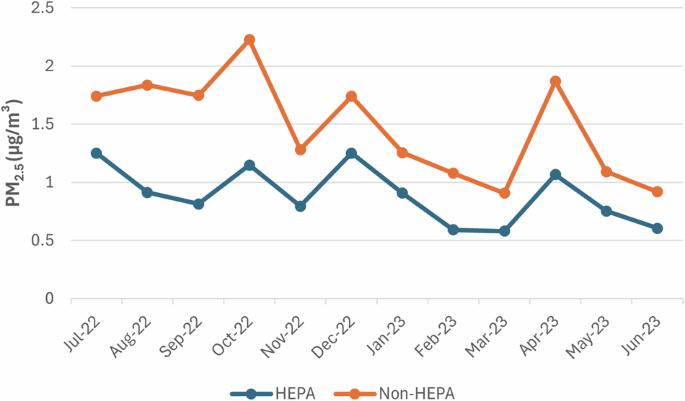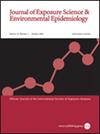便携式高效微粒空气净化器在教室空气质量随机交叉试验中的应用。
IF 4.7
3区 医学
Q2 ENVIRONMENTAL SCIENCES
Journal of Exposure Science and Environmental Epidemiology
Pub Date : 2025-01-11
DOI:10.1038/s41370-025-00743-9
引用次数: 0
摘要
背景:与生活在其他社区的儿童相比,生活在社会经济地位较低和少数民族人口较多的社区的儿童往往不成比例地暴露于颗粒物(PM)。目的:我们评估在现有暖通空调系统的教室中增加HEPA过滤器空气净化器是否可以减少室内空气污染。方法:从2022年7月至2023年6月,对17所洛杉矶联合学区小学进行了区域随机交叉试验,监测并比较了99个使用HEPA过滤器空气净化器的教室和87个使用非HEPA过滤器空气净化器的教室的PM浓度。结果:在HEPA教室中,平均学年PM2.5降低了39.9%(0.581µg/m³;根据学校的不同,教室的pm2.5比非hepa教室低13.8-82.4%。影响:很少有研究检查教室环境中的HEPA过滤,这是自COVID-19大流行以来首次评估教室中PM暴露的研究之一。通过一项有力的区域随机交叉试验,我们发现,与未安装HEPA过滤器的对照教室相比,在已经安装有MERV 13空气过滤器的HVAC系统的教室中添加便携式HEPA空气净化器,可测量的PM浓度更低,室外PM2.5的渗透更少。这表明,教室空气质量的进一步改善,特别是在环境负担沉重的社区,可以通过额外的过滤来实现。本文章由计算机程序翻译,如有差异,请以英文原文为准。

Classroom air quality in a randomized crossover trial with portable HEPA air cleaners
Children living in communities with lower socioeconomic status and higher minority populations are often disproportionately exposed to particulate matter (PM) compared to children living in other communities. We assessed whether adding HEPA filter air cleaners to classrooms with existing HVAC systems reduces indoor air pollution exposure. From July 2022 to June 2023, using a block randomized crossover trial of 17 Los Angeles Unified School District elementary schools, classroom PM concentrations were monitored and compared for 99 classrooms with HEPA filter air cleaners and 87 classrooms with non-HEPA filter air cleaners. In HEPA classrooms, average school-year PM2.5 was 39.9% lower (0.581 µg/m³; p < 0.001) and infiltration of outdoor PM2.5 into classrooms was 13.8–82.4% lower than non-HEPA classrooms, depending on the school.
求助全文
通过发布文献求助,成功后即可免费获取论文全文。
去求助
来源期刊
CiteScore
8.90
自引率
6.70%
发文量
93
审稿时长
3 months
期刊介绍:
Journal of Exposure Science and Environmental Epidemiology (JESEE) aims to be the premier and authoritative source of information on advances in exposure science for professionals in a wide range of environmental and public health disciplines.
JESEE publishes original peer-reviewed research presenting significant advances in exposure science and exposure analysis, including development and application of the latest technologies for measuring exposures, and innovative computational approaches for translating novel data streams to characterize and predict exposures. The types of papers published in the research section of JESEE are original research articles, translation studies, and correspondence. Reported results should further understanding of the relationship between environmental exposure and human health, describe evaluated novel exposure science tools, or demonstrate potential of exposure science to enable decisions and actions that promote and protect human health.

 求助内容:
求助内容: 应助结果提醒方式:
应助结果提醒方式:


